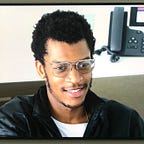Case Studies Pt.3: Pose for the Feature
It’s the end of Project 3 the UX Bootcamp I am attending. “So far so good” is the phrase running through my mind.
We were given the assignment to analyze an existing and adopted app and incorporate a new feature into the existing product. It would be based on an area of functionality to be explored and compared to user input.
My application in scope was Postmates, an American food delivery service owned by Uber that offers local delivery of restaurant-prepared meals and other goods.
The process presented for this assignment was open-ended. Not sure if it was intentional or not, but it gave me the opportunity to try an iterative design method.
Iterative Design is a cyclic process of prototyping, testing, analyzing refining based on the results of user testing.
The pros of using this process were that people’s responses gave me the straightforward insight needed to provide a solid feature.
The cons were that the scope of this project made for a small amount of testing.
Empathize
For this project, I considered both the customer and the company as the users and how their experiences formed over the life cycle of this application’s existence.
Postmates, a cool high-class company, wants to get restaurants to customers in an orderly fashion. There are times when Postmates provides this service for a solid price and other times when its customers look elsewhere for a less expensive deal.
To improve on its value, Postmates adds deals and a more contemporary design to their brand.
The customer, busy on a daily basis and almost always strapped for time, is hungry and is seeking a meal worth their time and hard-earned money.
In the middle of their daily routine, they seek a quick and easy way to order a meal.
My goal was to find a solution that can improve the experience for both the company and the customer. I decided to split it between the business and its point of view, the customer’s opinion, and the connection they have with each other.
Define
The aim for the definition phase was to identify what type of user would most likely need the functionality of this new feature. As mentioned, I assumed the customer to be a busy individual and does not have time to waste on an unsatisfactory meal.
When I had begun making this character I had given them personality traits such as inpatient, short-tempered, and aggravated especially when they haven’t had something to eat.
Taking this direction also made it possible to reveal some underlying issues and consequences the company may have as well as solutions that could solve these problems. I used Problem and Hypothesis statements to clarify these points.
At first, this made it easy to introduce the feature I had once called “The Hangry Tab”, but after the second user test and creating user journeys and flow, this had changed to something more subtle.
Ideate
When brainstorming solutions, I wanted to introduce more ways of thinking about introducing solutions. When I felt stumped on what direction I should take with my proposed feature, I used mind maps to organize what I wanted my feature to define, and a MoSCoW method to determine what I need to have and what I didn’t.
There was a moment when working through this assignment when I felt a great concern for those who were starving and found it difficult to get a meal. I also thought about the dangers of unhealthy eating. This gave me an insight into the death and disorders a lack or abundance of food could bring. This pushed me out of the scope of the project, But if I could do it differently, this would have been my top priority.
Prototype
I went a bit off the rocker with the prototypes. When creating prototypes for this application, I found it to be simplistic and modern, so the overall layouts were rather standard. The low-fidelity prototypes were so subtle, by the time I came to my mid-fidelity, I just had to add some color.
This was more of an aid to understanding where features could be added, rather than finding out what was wrong with the application. Since that was established earlier in the design process, my mid-fidelity was here to answer a new question.
Where are the areas in this application a feature can be added?
Testing
Conclusion
To conclude this assignment, a presentation was compiled to show the entire process. You can view my final feature here.
Final Thoughts
I am still very intrigued about the process of design thinking, but I can now say behind the glitter and glam of it, the method of:
Empathizing > Defining > Ideating > Prototyping > Testing
Is pretty streamlined. Is this a good/bad thing? Depends on how it’s looked at.
Before this experience, shaking things up in design was kind of my thing. And as long as there was a reason for something being made, everything worked out.
With UX, there has to be a reason for the reason you’re making something.
There is a lot of admitting to design is a science to be done. I wouldn’t say I’m troubled or lost by any new methods or tools introduced in this cohort. My only off-put is the rigid output that may come from it. I’m looking forward to a refreshing way to look at design thinking, but maybe I should take it easy on all these expectations.
“The more things change the more they stay the same”
Jean-Baptiste Alphonse Karr
